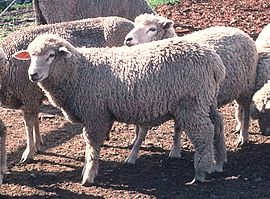- Corriedale
-
Corriedale sheep are a dual purpose breed, meaning they are used both in the production of wool and meat. The Corriedale is the oldest of all the crossbred breeds, a Merino-Lincoln cross developed almost simultaneously in Australia and New Zealand[1] and first brought to the United States in 1914. The Corriedale is internationally farmed, in Australia, New Zealand, the United States of America and Patagonia (it being one of the most popular sheep breeds in Uruguay).
Contents
Appearance and behaviour
Corriedale have a long life span, and are hardy and evenly balanced all over the body. Corriedales are docile, easy care mothers, with high fertility. They adapt well to a wide range of climate conditions. They are large framed and plain bodied, hornless and have a broad body. Corriedales produce a thick stapled, bulky fleece, which is popular with spinners and can be used for a range of handspun garments. Their dense fleece is medium-fine and high yielding, with good length and softness, somewhat between medium wool and long wool. Corriedale lambs produce good quality carcases and have a high pelt value.
The Corriedale produces bulky, high-yielding wool ranging from 31.5 to 24.5 microns[2] diameter. Fleece from a mature ewe will weigh 10 to 17 lb (4.5 to 7.7 kg) with a staple length of 3.5 to 6.0 in (8.9 to 15 cm). After cleaning, a yield of 50 to 60% of the raw fleece weight is common. Mature rams will weigh 175 to 275 lb (79 to 125 kg), ewes can weigh from 130 to 180 lb (59 to 82 kg).[3]
History
Corriedale sheep being fed on a Montana ranch
This breed was developed in Australia and New Zealand by extensive breeding and culling as a cross between Merino and Lincoln sheep.[4] The goal was to develop a breed that would thrive in lower rainfall areas and supply long staple wool. James Little was the original breeder and the name comes from a property in the South Island, where he conducted his work under the encouragement of NZALC superindent, William Soltau Davidson.[5]
The breed was developed between 1868 and 1910. As a dual purpose breed of sheep (good for meat and wool), the Corriedale breed was gradually distributed to many of the sheep-raising areas in the world. For example, the first Corriedales came to the United States in 1914.[3] The Corriedale was later used as one of the parents of the U.S.-developed Targhee breed. Corriedale sheep also contribute about 50 percent of the genetics used in the Gromark breed of sheep that were developed in Australia.[6]
References
- ^ Stock Types, The Land, North Richmond, c.1988
- ^ Preparation of Australian Wool Clips, Code of Practice 2010-2012, Australian Wool Exchange (AWEX), 2010
- ^ a b "Corriedale". Breeds of Livestock. Oklahoma State University, Dept. of Animals Science. http://www.ansi.okstate.edu/breeds/sheep/corriedale/index.htm. Retrieved 2009-04-09.
- ^ Aust. Corriedale Assoc. Retrieved on 23 May 2009
- ^ "CORRIEDALE: ORIGIN AND HISTORY". Sheep Breeds. New Zealand Sheepbreeders' Association. http://www.nzsheep.co.nz/corriedale/index.htm. Retrieved 2009-04-09.[dead link]
- ^ Sheep breed compendium, Australian Wool Exchange (AWEX), 2010
External links
Categories:- Sheep breeds originating in Australia
- Sheep breeds originating in New Zealand
Wikimedia Foundation. 2010.


